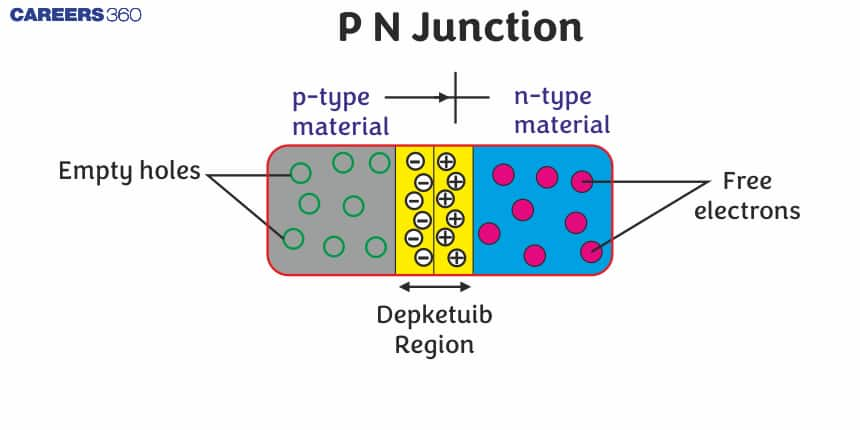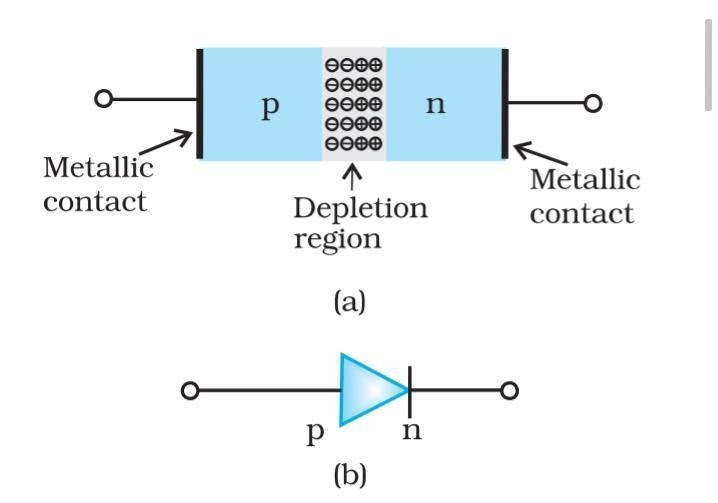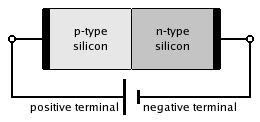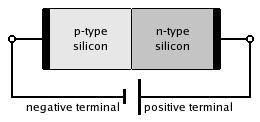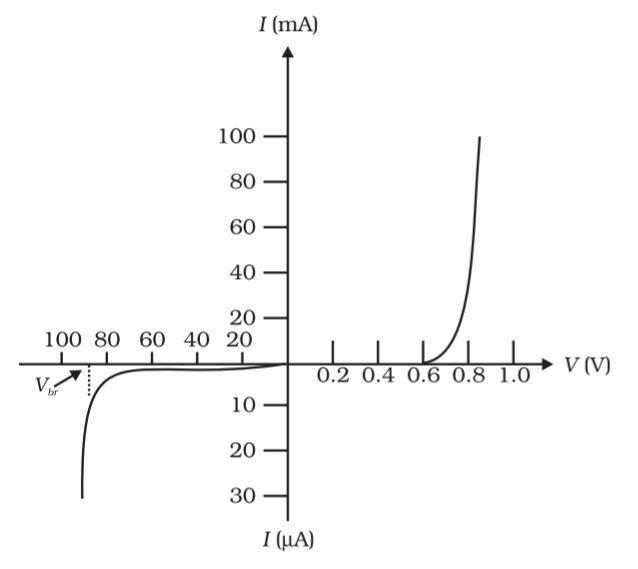1. Define diffusion current and drift current in pn junction diode.
The current induced when the electrons diffuse from n-side to p-side and holes diffuse from p-side to n-side in the pn junction due to concentration gradient is called diffusion current.
There is a movement of minority charge carriers of p-side and n-side from p ? n and n ? p due to the electric field of charges of depletion region. This motion of charge carriers due to electric field is known as drift current.
2. Define forward biased pn junction diode.
When the p-side of the pn junction is connected to positive terminal of battery, n-side of the pn junction is connected to the negative terminal of the battery, then the pn junction is forward biased.
3. Define Reverse bias pn junction diode.
When the p-side of the pn junction is connected to -ve terminal of the battery and n-side of pn junction is connected to the positive terminal of the battery, then pn junction is reverse bias pn junctioned.
4. Differentiate between n-type semiconductors and p-type semiconductors?
In p-type semiconductors doping is done by a trivalent element and holes are majority charge carriers. Whereas, in n-type semiconductors doping is done by a pentavalent element and electrons are majority charge carriers.
5. What is depletion region in pn junction?
A thin layer on both p and n side of pn junction which consist of ionized immobile negative and positive ions left behind by electrons and holes during diffusion is known as depletion region.
6. How does a P-N junction behave as a rectifier?
A P-N junction acts as a rectifier by allowing current to flow easily in one direction (forward bias) while blocking it in the other direction (reverse bias). This property is used to convert alternating current (AC) to direct current (DC) in power supplies and other electronic devices.
7. How does temperature affect a P-N junction?
Increasing temperature increases the number of electron-hole pairs generated thermally in the semiconductor. This leads to an increase in the reverse saturation current and a decrease in the forward voltage required for conduction. The overall effect is a reduction in the junction's resistance.
8. What is breakdown voltage in a P-N junction?
Breakdown voltage is the reverse bias voltage at which a P-N junction's resistance drops sharply, allowing a large current to flow. This occurs when the electric field in the depletion region becomes strong enough to break covalent bonds, creating a large number of electron-hole pairs.
9. What are the two main types of breakdown in P-N junctions?
The two main types of breakdown are:
10. What is the capacitance of a P-N junction, and how does it change with bias?
P-N junction capacitance, also called depletion capacitance, is the ability of the junction to store charge in the depletion region. It decreases with increasing reverse bias (as the depletion region widens) and increases with forward bias (as the depletion region narrows).
11. How is a P-N junction formed?
A P-N junction is formed by doping adjacent regions of a semiconductor crystal with different impurities. One region is doped with acceptor impurities to create a P-type material, while the other is doped with donor impurities to create an N-type material. When these two regions are brought into contact, a junction is formed at their interface.
12. What happens at the P-N junction when it's first formed?
When a P-N junction is first formed, electrons from the N-type region diffuse into the P-type region, and holes from the P-type region diffuse into the N-type region. This creates a depletion region at the junction, where there are no free charge carriers. An electric field is established across this region due to the charge imbalance.
13. How does the doping concentration affect the properties of a P-N junction?
Higher doping concentrations result in:
14. What is the built-in potential of a P-N junction?
The built-in potential, also called the contact potential, is the potential difference that naturally exists across a P-N junction at equilibrium (no external voltage applied). It results from the diffusion of charge carriers across the junction and typically ranges from 0.6 to 0.7 volts for silicon.
15. What is the difference between drift and diffusion currents in a P-N junction?
Drift current is caused by an electric field pushing charge carriers through the semiconductor. Diffusion current is caused by the movement of charge carriers from regions of high concentration to regions of low concentration. In a P-N junction, both types of currents contribute to the total current flow.
16. What is a P-N junction?
A P-N junction is the boundary or interface formed when a P-type semiconductor material is brought into contact with an N-type semiconductor material. This junction is the fundamental building block of many semiconductor devices, including diodes and transistors.
17. How does a P-N junction diode differ from an ideal diode?
Unlike an ideal diode, a real P-N junction diode:
18. What is the significance of the knee voltage in a P-N junction diode?
The knee voltage, also called the cut-in voltage or threshold voltage, is the forward voltage at which the diode starts to conduct significantly. It represents the point where the applied voltage overcomes the built-in potential barrier of the junction.
19. What is the role of minority carriers in a P-N junction?
Minority carriers (electrons in P-type and holes in N-type) play a crucial role in the reverse current of a P-N junction. They are responsible for the small reverse saturation current and contribute to the junction's temperature sensitivity and switching characteristics.
20. What is a varactor diode, and how does it use the P-N junction properties?
A varactor diode, also known as a varicap, is a P-N junction diode designed to exploit the voltage-dependent capacitance of the depletion region. By varying the reverse bias voltage, the capacitance can be changed, making varactors useful in voltage-controlled oscillators and tuning circuits.
21. What is the depletion region in a P-N junction?
The depletion region is an area at the P-N junction where free charge carriers (electrons and holes) have diffused across the junction and recombined, leaving behind fixed charged ions. This region is "depleted" of mobile charge carriers and acts as an insulator.
22. How does the width of the depletion region change with applied voltage?
When a forward bias is applied (positive voltage to P-type, negative to N-type), the depletion region narrows. When a reverse bias is applied (negative voltage to P-type, positive to N-type), the depletion region widens. This change in width affects the junction's electrical properties.
23. What is forward bias in a P-N junction?
Forward bias occurs when a positive voltage is applied to the P-type material and a negative voltage to the N-type material. This reduces the potential barrier at the junction, allowing current to flow more easily through the device.
24. What is reverse bias in a P-N junction?
Reverse bias occurs when a negative voltage is applied to the P-type material and a positive voltage to the N-type material. This increases the potential barrier at the junction, making it difficult for current to flow through the device.
25. Why does a P-N junction conduct current easily in forward bias but not in reverse bias?
In forward bias, the applied voltage reduces the potential barrier at the junction, allowing majority carriers to easily cross. In reverse bias, the potential barrier increases, making it difficult for majority carriers to cross. Only a small current due to minority carriers (reverse saturation current) flows in reverse bias.
26. How does a P-N junction behave under AC voltage?
Under AC voltage, a P-N junction alternately experiences forward and reverse bias. During the positive half-cycle, it conducts (forward bias), and during the negative half-cycle, it blocks current (reverse bias). This behavior makes P-N junctions useful for rectification and signal processing.
27. How does light affect a P-N junction?
When light falls on a P-N junction, it can create electron-hole pairs. If these pairs are created within or near the depletion region, they can be separated by the built-in electric field, generating a photocurrent. This is the principle behind photodiodes and solar cells.
28. How does a Zener diode differ from a regular P-N junction diode?
A Zener diode is a heavily doped P-N junction designed to operate in the reverse breakdown region. Unlike regular diodes, Zener diodes maintain a nearly constant voltage across them when reverse-biased beyond their breakdown voltage, making them useful for voltage regulation.
29. What is the transit time in a P-N junction, and why is it important?
Transit time is the time taken by charge carriers to cross the depletion region. It's important because it limits the high-frequency performance of the device. Shorter transit times allow the diode to respond to higher frequency signals, making it suitable for high-speed applications.
30. How does the P-N junction behave at very high frequencies?
At very high frequencies, the P-N junction's behavior is affected by:
31. What is the difference between abrupt and graded P-N junctions?
An abrupt P-N junction has a sharp transition between P-type and N-type regions, while a graded junction has a gradual change in doping concentration. Graded junctions typically have lower capacitance and can handle higher voltages, but abrupt junctions are easier to manufacture and have more predictable characteristics.
32. How does a P-N junction function as a temperature sensor?
The forward voltage drop across a P-N junction decreases linearly with increasing temperature. This predictable relationship allows P-N junctions (often in the form of diodes) to be used as accurate temperature sensors in electronic circuits.
33. What is the avalanche effect in a P-N junction?
The avalanche effect occurs when charge carriers in the depletion region gain enough energy from a strong electric field to knock electrons out of atoms through collisions. This creates more charge carriers, which in turn create even more, leading to a rapid multiplication of carriers and a sudden increase in current.
34. How does a P-N junction behave under pulsed conditions?
Under pulsed conditions, a P-N junction's behavior is influenced by:
35. What is the difference between static and dynamic resistance of a P-N junction?
Static resistance is the ratio of voltage to current at a specific operating point on the diode's I-V curve. Dynamic resistance is the instantaneous rate of change of voltage with respect to current (dV/dI) at a given operating point. Dynamic resistance is typically much lower than static resistance in the forward-biased region.
36. How does carrier recombination affect the behavior of a P-N junction?
Carrier recombination occurs when electrons and holes combine and annihilate each other. In a P-N junction, recombination affects:
37. What is the role of the P-N junction in a bipolar junction transistor (BJT)?
In a BJT, there are two P-N junctions: the emitter-base junction and the collector-base junction. These junctions control the flow of charge carriers through the transistor, allowing it to amplify signals or act as a switch. The forward-biased emitter-base junction injects carriers into the base, while the reverse-biased collector-base junction collects them.
38. How does a P-N junction behave under reverse recovery conditions?
Reverse recovery occurs when a diode transitions from forward to reverse bias. During this time:
39. What is the difference between drift and diffusion capacitance in a P-N junction?
Drift capacitance, also called depletion capacitance, is due to the change in charge stored in the depletion region with applied voltage. Diffusion capacitance is due to the change in charge stored by minority carriers in the neutral regions adjacent to the depletion region. Diffusion capacitance is dominant in forward bias, while drift capacitance is dominant in reverse bias.
40. How does the P-N junction in a solar cell convert light into electricity?
41. What is the role of surface effects in P-N junction behavior?
Surface effects in P-N junctions can include:
42. How does carrier lifetime affect the performance of a P-N junction?
Carrier lifetime is the average time a minority carrier exists before recombining. Longer carrier lifetimes result in:
43. What is the significance of the ideality factor in P-N junction diodes?
The ideality factor, typically denoted as n, describes how closely a diode follows the ideal diode equation. It ranges from 1 (ideal) to 2, with most practical diodes falling between these values. A higher ideality factor indicates greater deviation from ideal behavior, often due to recombination in the depletion region or high-level injection effects.
44. How does series resistance affect the behavior of a P-N junction diode?
Series resistance in a P-N junction diode, caused by the bulk resistance of the semiconductor and contact resistances, leads to:
45. What is the difference between homojunction and heterojunction P-N diodes?
A homojunction P-N diode is made from a single semiconductor material (e.g., silicon) with different doping on each side. A heterojunction P-N diode is made from two different semiconductor materials (e.g., GaAs and AlGaAs). Heterojunctions can offer advantages such as:
46. How does quantum tunneling affect P-N junctions in highly doped semiconductors?
In highly doped semiconductors, the depletion region becomes very narrow. This allows charge carriers to tunnel directly through the potential barrier, even at low voltages. This quantum tunneling effect:
47. What is the impact of junction depth on P-N junction characteristics?
Junction depth affects several P-N junction properties:
48. How does a P-N junction behave under extreme temperature conditions?
At very low temperatures:
49. What is the role of generation and recombination centers in P-N junctions?
Generation and recombination centers are impurities or defects in the crystal structure that can:
50. How does the P-N junction behave in the presence of ionizing radiation?
Ionizing radiation can create electron-hole pairs in the semiconductor, leading to:
